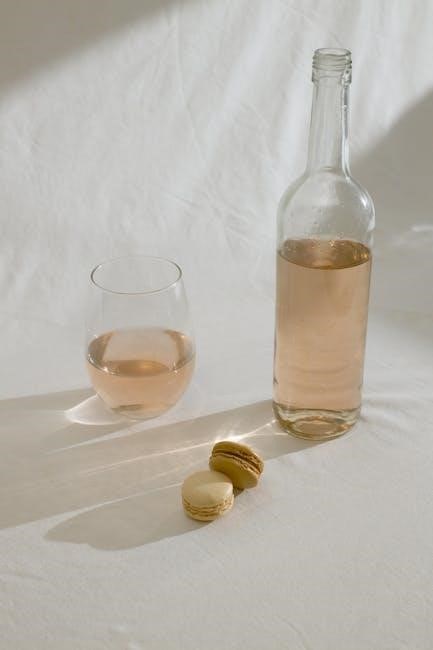White wine, crafted from white grapes through fermentation without skin contact, offers a crisp and refreshing profile. Its versatility makes it a popular choice globally, pairing well with various cuisines and featuring in numerous cultural celebrations.
Definition and Overview
White wine is an alcoholic beverage made from fermented white or occasionally red grapes, crafted without skin contact. It offers a wide range of styles, from dry to sweet, and is celebrated for its crisp acidity and aromatic profiles. Made primarily from Vitis vinifera grapes, white wine varies in color from pale yellow to golden, appealing to diverse palates worldwide.
A Brief History of White Wine
White wine’s history traces back thousands of years, with origins in ancient civilizations like Georgia, Greece, and Rome. Early techniques laid the groundwork for modern winemaking. Over centuries, its popularity grew, shaped by regional innovations and trade. Today, white wine remains a cornerstone of global viticulture, cherished for its diversity and timeless appeal.
Popular Types of White Wine
Popular white wines include Chardonnay, known for its buttery notes, Sauvignon Blanc for its citrus zing, and Pinot Grigio for crisp acidity. Riesling ranges from dry to sweet, while Albariño and Gewürztraminer offer unique flavor profiles. These varietals cater to diverse palates, making white wine a versatile choice for both casual sipping and special occasions.

Types of White Wine
White wines vary from crisp and dry to sweet and dessert styles, offering diverse flavor profiles like Chardonnay, Sauvignon Blanc, and Riesling, appealing to every palate.
Major White Wine Varietals
Chardonnay, Sauvignon Blanc, Riesling, Pinot Grigio, Albariño, and Viognier are prominent white wine varietals. Chardonnay offers buttery, oaky notes, while Sauvignon Blanc is crisp with citrus flavors. Riesling ranges from dry to sweet, and Pinot Grigio delivers a light, refreshing taste. These varietals showcase diverse profiles, appealing to a wide range of palates and preferences.
Regional Styles and Characteristics
Regional styles and characteristics shape white wines, influenced by climate, soil, and winemaking traditions. Marlborough, New Zealand, is famed for zesty Sauvignon Blanc, while France’s Loire Valley offers diverse whites like Sancerre and Vouvray. Germany’s Mosel region excels in Riesling, ranging from dry to sweet, and Oregon’s Big Salt co-fermented white wine is gaining popularity for its unique profile.
Dry vs. Sweet White Wines
White wines vary in sweetness levels, ranging from dry to sweet. Dry whites, like Chardonnay and Sauvignon Blanc, emphasize crisp acidity and fruit flavors. Sweet whites, such as Riesling and Moscato, offer residual sugar for a softer, sweeter taste. This diversity caters to different palates, making white wine a versatile choice for various occasions and pairings.

The Winemaking Process
White wine is crafted through fermentation of white grapes without skin contact, ensuring delicate flavors. After harvesting, grapes are pressed, fermented, and filtered to produce crisp, refreshing wines.
How White Wine is Made
White wine production begins with harvesting white grapes, which are promptly pressed to avoid skin contact. The juice is fermented at controlled temperatures to preserve delicate aromas and flavors. After fermentation, the wine is clarified, filtered, and aged, often in stainless steel or oak barrels, to enhance complexity before bottling and distribution.
Grape Selection and Harvesting
Winemakers select white grapes like Chardonnay, Sauvignon Blanc, and Pinot Grigio, prioritizing optimal ripeness and acidity. Harvesting often occurs early in the morning to preserve freshness. Grapes are gently pressed to extract juice without skin contact, ensuring delicate flavors and aromas are retained for fermentation, crucial for crafting high-quality white wines with balanced profiles.
Fermentation and Aging
White wine fermentation typically occurs in stainless steel or oak barrels, with precise temperature control to preserve delicate aromas. Oak aging adds complexity, while stainless steel maintains crispness. The duration varies, with some wines aged briefly for freshness and others longer to enhance texture and depth, resulting in a refined and balanced final product.

Health Benefits of White Wine
White wine may reduce the risk of sudden cardiac arrest and support heart health due to antioxidants. Moderate consumption, as part of a healthy lifestyle, can offer benefits.
White Wine and Heart Health
White wine may support heart health by reducing the risk of sudden cardiac arrest, with studies suggesting up to 63% of cases could be prevented through lifestyle changes; Antioxidants in white wine contribute to cardiovascular well-being, potentially lowering heart disease risks. Moderate consumption, as part of a balanced diet and active lifestyle, is key to these benefits.
Antioxidants and Other Health Advantages
White wine contains antioxidants like polyphenols, which help protect against oxidative stress and inflammation. These compounds may contribute to improved cardiovascular health, enhanced cognitive function, and a stronger immune system; Moderate consumption has also been linked to anti-aging benefits and reduced risks of certain chronic diseases, making it a potentially healthy choice when enjoyed responsibly.

Food Pairing with White Wine
White wine’s versatility complements a variety of dishes, from seafood to desserts. Crisp whites enhance seafood, while rich whites pair with poultry and creamy sauces, balancing flavors seamlessly.
Classic Pairings
Chardonnay pairs perfectly with roasted chicken, while Sauvignon Blanc complements goat cheese and fresh herbs. Riesling’s sweetness balances spicy Asian dishes, and Pinot Grigio enhances seafood like shrimp or fish tacos. These classic combinations highlight white wine’s ability to elevate diverse flavors, making it a versatile choice for any meal.
Matching Sweetness Levels to Dishes
White wines range from dry to sweet, each complementing dishes differently. Dry whites like Sauvignon Blanc pair with salads or seafood, while off-dry varieties such as Riesling balance mildly sweet dishes. Sweet white wines, like dessert wines, are perfect for rich or sugary meals, enhancing flavors and providing a harmonious contrast.
The Role of Acidity in Pairing
Acidity in white wine enhances its ability to complement a wide range of dishes. Crisp, high-acidity wines like Sauvignon Blanc cut through rich flavors, while lower-acidity varieties like Chardonnay pair well with creamier textures. Balancing acidity ensures harmony, making white wines versatile for pairing with everything from delicate seafood to robust cheeses and herbaceous dishes.
Serving White Wine
Serving white wine at the correct temperature enhances its flavor and aroma. Chilled between 45°F-55°F, it preserves crispness. Use appropriate glassware to maximize aroma and flavor profiles, ensuring a delightful experience.
Optimal Serving Temperatures
White wines are best served chilled to enhance their crisp acidity and delicate flavors. Lighter varieties like Sauvignon Blanc and Pinot Grigio shine at 45°F-50°F, while richer styles such as Chardonnay are ideal at 50°F-55°F. Avoid over-chilling to preserve aromatic complexity. Using an ice bucket or wine thermometer ensures precision, guaranteeing an optimal drinking experience for any white wine selection.
Choosing the Right Glassware
Selecting the right glassware enhances the white wine experience. A narrower bowl for crisp whites like Sauvignon Blanc preserves acidity, while a wider bowl suits richer styles like Chardonnay, allowing aromas to unfold. Stemmed glasses are ideal for swirling, releasing flavors. Avoid oversized glasses to prevent oxidation and maintain the wine’s delicate character, ensuring an optimal tasting experience for every varietal.
Storage and Aging Tips
Store white wine in a cool, dark place with consistent humidity, ideally between 45-55°F. For most whites, short-term storage is recommended, as they are meant to be consumed young. However, aged varieties like Chardonnay can benefit from 2-5 years of aging. Use a wine fridge for optimal conditions, and avoid exposure to direct sunlight or heat sources. For affordable blends, store for 2-3 years to preserve freshness. Proper storage enhances flavor and aroma, ensuring a superior tasting experience. Always check the wine’s specific aging potential before storing long-term, as some varieties degrade quickly.
Popular White Wine Regions
France, Germany, Italy, and Austria are renowned for their white wines, with regions like Loire Valley, Mosel, Tuscany, and Marlborough producing exceptional varieties, each showcasing unique terroir characteristics.
Key Wine-Producing Countries
France, Germany, Italy, and New Zealand are leading producers of white wine, with regions like Loire Valley, Mosel, Tuscany, and Marlborough excelling in varietals such as Sauvignon Blanc, Riesling, and Pinot Grigio. The United States, particularly Napa Valley, also contributes significantly with Chardonnay and other styles, showcasing diverse terroir and winemaking techniques.
Regional Specialties and Terroir
Regional terroir greatly influences white wine’s flavor profile. Loire Valley’s chalky soils enhance Sauvignon Blanc’s minerality, while Mosel’s slate soils add complexity to Riesling. Marlborough’s maritime climate creates crisp, citrusy Sauvignon Blanc. Italy’s Tuscany produces Vernaccia with herbal notes, and Germany’s Baden crafts rich Pinot Blanc. Each region’s unique conditions and techniques shape distinct wine styles, reflecting local traditions and environmental characteristics.
Lesser-Known White Wine Varieties
Beyond popular varieties, lesser-known white wines like Albariño from Spain and Grüner Veltliner from Austria offer unique flavor profiles, adding diversity to any wine collection.
Exploring Rare and Unique Varietals
Rare white wines like Big Salt from Oregon offer distinctive flavors, blending tradition with innovation. These unique varietals, often overlooked, provide exciting discoveries for adventurous drinkers, enriching the world of white wines with their exceptional profiles and craftsmanship.
Regional Hidden Gems
Discover hidden treasures like Vinho Verde’s crisp whites or Bordeaux’s lesser-known blends. Regions such as New Zealand and Spain offer unique varieties like Albariño, showcasing distinct terroir and winemaking traditions that captivate adventurous palates with their originality and charm.

Cultural Impact of White Wine
White wine holds profound cultural significance, often central to celebrations and traditions worldwide, symbolizing joy and unity in toasts and ceremonies, reflecting lifestyle trends and social gatherings.
White Wine in Tradition and Celebration
White wine has long been a symbol of joy and unity in cultural and religious ceremonies. From wedding toasts to festive gatherings, it enhances celebrations, embodying elegance and camaraderie. Its presence in rituals and special occasions underscores its cultural significance, transcending mere beverage to become a meaningful tradition across global societies and generations alike, fostering connection and shared memories.
White Wine and Lifestyle Trends
White wine aligns with modern lifestyle trends, appealing to health-conscious consumers and social enthusiasts alike. Its versatility in pairings and mild alcoholic content makes it a popular choice for casual gatherings and sophisticated events. The rise of imported wines and affordable blends further caters to diverse preferences, reflecting evolving tastes and the pursuit of balanced, enjoyable living.

Cooking with White Wine
White wine enhances culinary dishes by adding depth and complexity to sauces, marinades, and poached recipes, making it a versatile ingredient in both savory and sweet creations.
White Wine in Culinary Dishes
White wine is a versatile ingredient in cooking, enhancing sauces, marinades, and poached recipes. It adds a delicate flavor to dishes like seafood, poultry, and desserts. Big Salt, an Oregon co-fermented white wine, is gaining popularity as a unique addition to culinary creations. Its crisp acidity and subtle notes make it ideal for elevating both savory and sweet dishes, while its versatility ensures it remains a kitchen staple.
Using White Wine in Desserts
White wine adds a sophisticated twist to desserts, enhancing flavors without overpowering them. It pairs beautifully in sweet and creamy dishes like panna cotta or as a poaching liquid for fruits. Dessert wines, such as Moscato or Riesling, bring a delicate balance of acidity and sweetness, making them ideal for recipes like wine-infused chocolates or sabayon. The subtle complexity elevates any dessert, offering a refined finish.
Market Trends in White Wine
The market is seeing a surge in imported white wines, with New Zealand reporting 40% of consumption now from overseas, up from 35% a decade ago.
Rise of Imported Wines
Imported white wines are gaining significant traction, with New Zealand reporting that nearly 40% of its wine consumption now comes from international labels, marking a notable shift from the 35% share a decade ago. This trend reflects a growing appreciation for diverse global varietals and styles, driving market expansion and consumer interest in new regions.
Affordable White Wine Blends
Affordable white wine blends are becoming increasingly popular, offering quality and value for budget-conscious drinkers. These wines often combine multiple varietals, creating balanced flavors at accessible prices. Many winemakers, like Ryan Zepaltas, highlight the appeal of these blends as an entry point for exploring diverse white wine styles without breaking the bank.
Personal Recommendations
Explore must-try white wines like Chardonnay, Sauvignon Blanc, and Riesling for their unique profiles. Discover emerging trends by venturing into lesser-known varietals for a refreshing twist on tradition.
Must-Try White Wines
From crisp Sauvignon Blanc to rich Chardonnay, explore must-try white wines like Pinot Grigio and Riesling. A visual guide helps you discover these and lesser-known varieties, fitting into major styles for a refreshing twist on tradition.
Emerging Trends to Watch
Explore the rise of imported white wines and affordable blends gaining popularity. Discover innovative techniques like co-fermentation and sustainability practices reshaping winemaking. Trends include lighter styles, unique grape varieties, and health-conscious options, reflecting evolving consumer preferences and a growing interest in organic and natural wines.
White wine offers a world of diversity, from crisp Sauvignon Blanc to rich Chardonnay. Its versatility and health benefits make it a timeless choice for celebrations and everyday enjoyment.
Final Thoughts on White Wine
White wine’s diversity captivates palates, offering styles from crisp to rich. Its health benefits and versatility in pairings make it a timeless choice for celebrations and everyday enjoyment, inviting exploration and appreciation across cultures and cuisines.

Encouragement to Explore Further
Embark on a journey to discover the vast world of white wines. Experiment with lesser-known varieties and regional styles to uncover hidden gems. Whether through cooking, pairing, or sipping, let curiosity guide your exploration of this versatile and delightful beverage, ensuring countless moments of discovery and enjoyment.